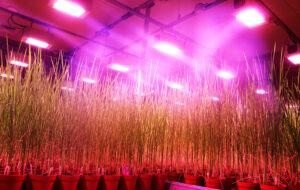by Pramod Gorakhanath Kabade, Shilpi Dixit, Uma Maheshwar Singh et al.
SpeedFlower for indica and japonica rice offers a promising solution for addressing the limitations of longer generation times and seasonal constraints. The reduction in generation times by almost half can result in a faster varietal release process and ultimately increase in genetic gain. The speed breeding protocol can enable the development of new high-yielding rice varieties in a much shorter duration, ultimately contributing to global food security.
The rate of genetic gain attained in major agricultural crops thus far is inadequate to satisfy the necessary food demands. The average estimated rate of genetic gain in rice drought breeding programs is 0.13% (2.29 kg/ha/year), while in irrigated breeding programs, it is 0.23% (8.75 kg/ha/year). However, these rates are insufficient to meet the increasing future demands for rice with a growing population.
The Breeder’s equation suggests that genetic gain can be enhanced by improving additive genetic variation within the population (ra), increasing selection intensity (i), and improving selection accuracy (r), while decreasing the generation time (l ) required to achieve the desired outcome (DG = (ra) (i)(r)/l ). It is generally considered that one of the simplest ways to increase genetic gain is to reduce the time of the breeding cycle.
Over time, various breeding techniques such as pedigree, bulk, modified bulk, single seed descent, doubled haploid, and rapid generation advancement (RGA) have been utilized for self-pollinated crops to decrease generation times and facilitate the development of new varieties.
The Speed Breeding (SB) technique has been introduced to manage environmental factors effectively and is suitable for short- and long-day crops, allowing it to be utilized throughout the year. As a result, SB has gained popularity as a method for advancing multiple generations per year. The first detailed results on SB, which accelerates flowering and generation time through controlled environmental conditions such as extended photoperiod, light intensity, temperature, and early harvest of premature seeds in long-day crops have been reported by numerous researchers.
An SB protocol was used to advance four generations of canola and six generations of spring and durum wheat, barley, peas, and chickpeas, achieving a faster rate compared to the two to three generations possible in a glasshouse. Additionally, SB allowed crossing and inbreeding (8–12 generations) to be completed within 2 years rather than 6–7 years in field conditions.
SB also enabled the development of one of the world’s first wheat varieties with high protein milling features. Short-day crops such as soybean, rice, and amaranthus have also been optimized using SB protocols.
A biotron speed-breeding technique involving optimized photo-period, day and night temperatures, and humidity was used to introduce the salinity tolerance gene (hst1) in the japonica rice variety Yukinko-ma. The resulting BC3F3 population was developed over 17 months. Its field performance was evaluated, with the plants exhibiting performance similar to their counterparts grown under field conditions after being shifted from SB conditions.
However, this protocol involves tiller removal and embryo rescue, which may not be practical for large populations. Meanwhile, an SB protocol was developed for soybeans that can accommodate up to five generations using optimized light spectrum, intensity, and photoperiod.
They also induced early flowering in two japonica rice varieties by using far-red (FR) light, resulting in a 20-day reduction in flowering time. However, despite early flowering in two japonica rice accessions, the remaining accession did not flower early under the same conditions and displayed genotype-specific responses.
The utilization of SB in glasshouses and controlled chambers has the potential to enhance breeding outputs for both short- and long-day crops. This is achieved by providing more controlled growth conditions, which work more uniformly for diverse germplasm and breeding materials compared to field conditions. One example is the acceleration of flowering in some genotypes of rice and amaranth using different spectrum ratios and FR light.
Moreover, a speed vernalization protocol for winter crops like wheat and barley that allowed five generations per year was developed using SB conditions. Recently, SB protocols with up to six generations were also optimized with different light conditions in the case of Cannabis sativa and cassava.
The success of SB in various crops has led us to establish a state-of-the-art SpeedBreed Facility at the International Rice Research Institute, South Asia Regional Centre (ISARC), Varanasi, India. This facility aims to optimize the SB protocol for all types of rice varieties without the need for tedious embryo rescue techniques and tiller removal.
The optimized protocol works for all the maturity durations of indica and japonica rice (early, medium, and late) and enables synchronous flowering. Further validation of the developed protocol on a 3000 rice genomes project (3K RGP) panel representing different groups of Oryza sativa L. confirmed the results.
The study emphasizes the importance of understanding plant physiological responses to photobiological entities such as light spectrums, light intensity, photoperiod, and other growth parameters such as temperature, humidity, and foliar fertilizer management for successful SB.
The research also provides insights into rice growth stages and the factors affecting early flowering and maturation. This can help develop stage-specific interventions and comprehensive SB protocols in rice breeding. Overall, the SpeedBreed facility and protocol have the potential to significantly speed up rice breeding and improve the efficiency of the process, which could be extended across crops to enhance genetic gains.
Establishing a fully controlled SB facility with an optimized comprehensive protocol, SpeedFlower for indica and japonica rice offers a promising solution for addressing the limitations of longer generation times and seasonal constraints. The reduction in generation times by almost half can result in a faster varietal release process and ultimately increase in genetic gain.
Therefore, SpeedFlower can enable the development of new high-yielding rice varieties in a much shorter duration, ultimately contributing to global food security.
Read the study:
Kabade PG, Dixit S, Singh UM et al. (2023) SpeedFlower: a comprehensive speed breeding protocol for indica and japonica rice. Plant Biotechnol. J.






